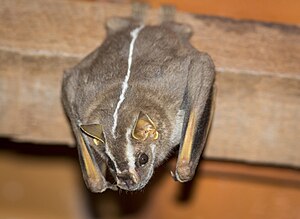Morcego strip fruit vampire
| Morcego strip fruit vampire | ||||||||||||
|---|---|---|---|---|---|---|---|---|---|---|---|---|

Morcego strip fruit vampire ( Platyrrhinus recifinus ) |
||||||||||||
| Systematics | ||||||||||||
|
||||||||||||
| Scientific name | ||||||||||||
| Platyrrhinus recifinus | ||||||||||||
| ( Thomas , 1901) |
The bat species Morcego strip fruit vampire ( Platyrrhinus recifinus ) belongs to the family of leaf noses (Phyllostomidae) and is native to Brazil .
description
With a total length of 58.4 to 60.8 mm, a forearm length of 39.9 to 43.5 mm and a weight of 14 to 19 g, the Morcego striped fruit vampire is a medium-sized representative of the genus of the striped fruit vampire . Like other species of this genus, Platyrrhinus recifinus also has a distinctive light-colored stripe on its back, which begins between the ears and ends at the tail membrane, as well as a stripe above and below the eyes. The coat color varies between gray and brown, with a lighter belly area. The feet are covered with hair. The type is greater than the sympatrically occurring Platyrrhinus incarum and less than P. lineatus . The upper incisors are also jagged three times instead of two, unlike the other two species. As a representative of the leaf noses , Platyrrhinus recifinus has a pronounced nasal leaf .
Way of life
The Morcego strip fruit vampire lives in forested areas near the Atlantic coast , in both primary and secondary forest . Like most bats, it is nocturnal. During the day, the species can be found in small groups of up to 10 individuals in hollow trees, under leaves or in caves. The preferred foods include fruits from ant trees (genus Cecropia ) and figs (genus Ficus ).
distribution and habitat
The Morcego strip fruit vampire is endemic to Brazil and is classified as safe by the IUCN .
literature
- V. da Cunha Tavares & PM Velazco (2010): Platyrrhinus recifinus. In: Mammalian Species . No. 859, pp. 119-123.